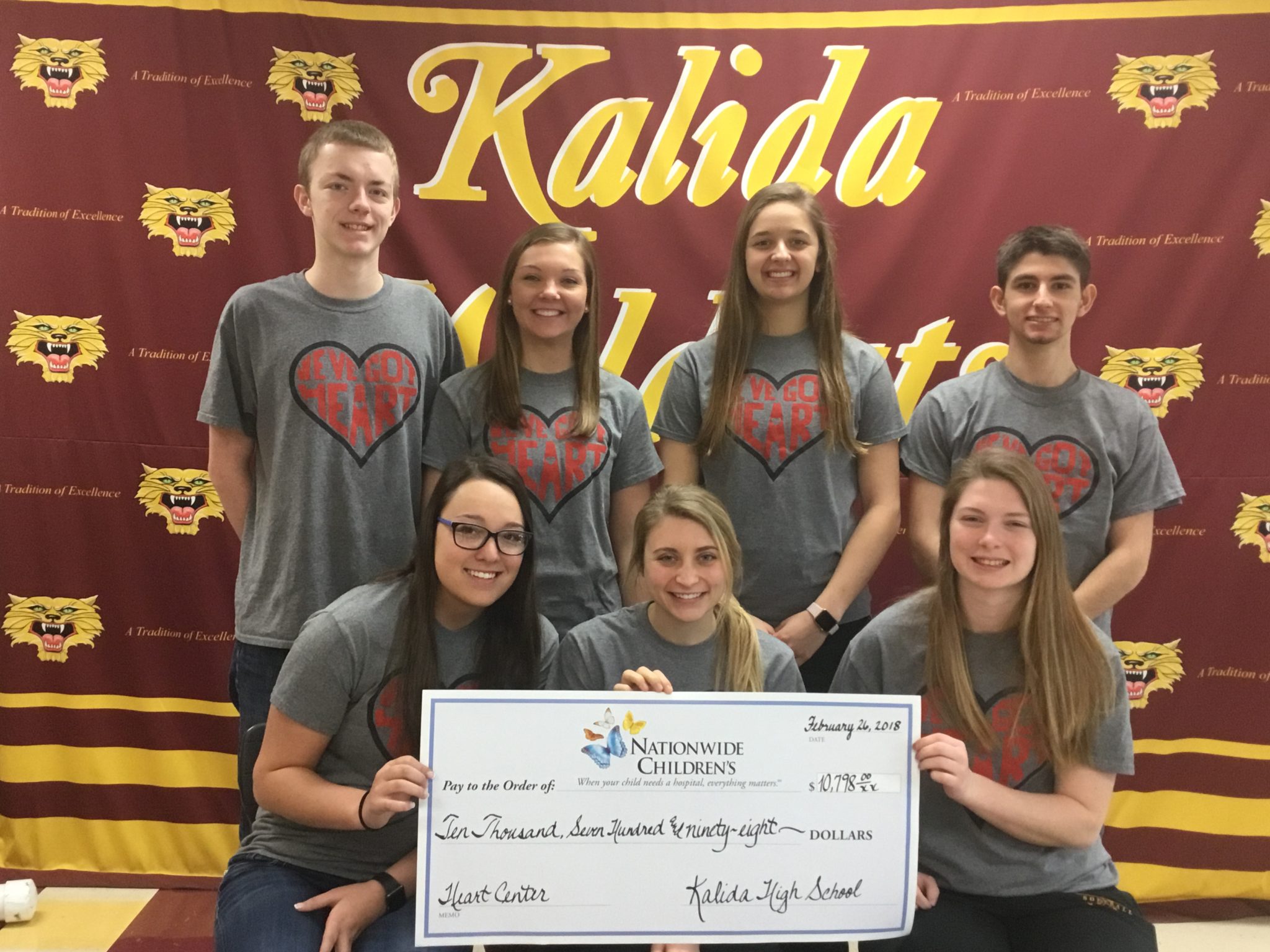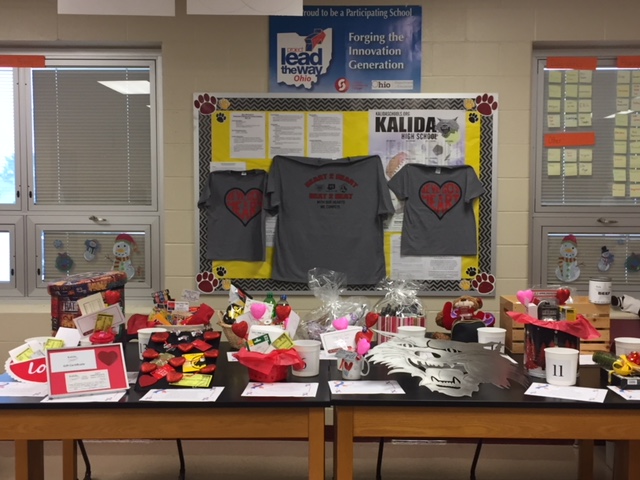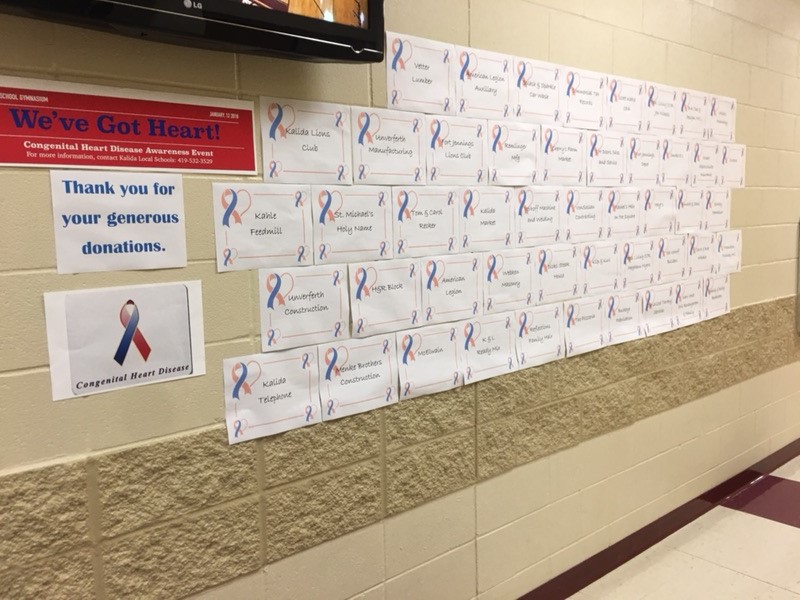Last fall, OSLN presented Ohio’s students with a statewide design challenge: Work as a team to fight heart disease and help your community become heart healthy. The Ohio Heart Health Design Challenge aimed to get students and their teachers thinking about, and acting to combat, heart disease, which is the No. 1 killer of men and women. Taking up that challenge, a handful of students at Kalida High School held an event in January — titled “We’ve Got Heart!” — that raised awareness in two communities about congenital heart defects (CHD) plus more than $10,000 to fund CHD research. We asked the students’ teacher, Darla Warnecke, a Project Lead the Way Biomedical Science instructor, to share details about her students’ efforts and what it meant to the two communities in northwestern Ohio’s Putnam County. We also asked one of the students, Taylor Lucke, to describe how her research, event planning and fundraising touched her. First, teacher Darla Warnecke:
Q: What prompted students to undertake the “We’ve Got Heart!” event?
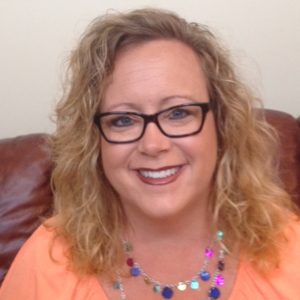 A: In my Biomedical Innovations class, students are typically asked to complete an independent project; this year, I encouraged the students to work collaboratively in a small group. The guidelines for the project included selecting a topic that is of interest, determining the purpose of the project and researching information for the creation of the final product.
A: In my Biomedical Innovations class, students are typically asked to complete an independent project; this year, I encouraged the students to work collaboratively in a small group. The guidelines for the project included selecting a topic that is of interest, determining the purpose of the project and researching information for the creation of the final product.
Students were presented the introductory materials for the Ohio Heart Health Design Challenge. A brainstorming session resulted in students addressing a local heart-health situation of a high school student from a neighboring town (Fort Jennings, Ohio).
Students shared information about the situation that resulted in this young man being hospitalized and requiring surgery. My students learned this young man was born with a congenital heart defect (CHD) and recently encountered complications surrounding his heart health. It took only minutes before my students were naming off other local students with CHD.
At this point, the students did some research to learn about the variety of defects and the diverse medical interventions and required treatments. This was the beginning of Kalida’s Ohio Heart Health Design Challenge. Students wanted to raise awareness of CHD and raise money to promote CHD research.
A list of students with CHD from our school district and the neighboring district was created. The families were contacted and permission granted for my class to host an event in honor of the CHD survivors. The logical time for the event was during the boys’ basketball game between the districts’ two teams.
We reached out to the other school, Fort Jennings, and got their school and community involved. The boys basketball team and cheerleading squad from Fort Jennings purchased and wore “We’ve Got Heart!” T-shirts as part of their uniforms that evening. Their school population and community really got involved by also purchasing T-shirts. Many businesses in Fort Jennings made donations, either monetary or raffle basket items, to the “We’ve Got Heart!” event.
Q: How did the students go about planning the event?
A: The students started by dividing up the event into categories. Pre-event, during the event, and post-event categories were established. Shortly after, students realized the divisions needed to be more specific, and they needed to assign a person in charge for each division. This was where the awareness component was fine-tuned.
Each student was put in charge of one of the awareness components. These included event advertising flyers and posters, newspaper and church bulletin articles, school announcement facts and guests of honor biographies to use with our local heart story presentation, honor wall and CHD poster display.
After interviewing the local CHD families, my students identified specific heart defects and began to learn about the congenital defects affecting our guests of honor. The CHD family questions allowed us to create guest of honor biographies for use in our presentation. The planning for “We’ve Got Heart!” was incorporated into the Biomedical Innovations curriculum.
Within the course, students were introduced to components of a research project, and I modified the traditional assignment specifics to fit the Ohio Heart Health Design Challenge parameters.
Q: What were the various parts of the event? What was the community response?
A: The broad parts of the event included an awareness component and a fundraising component.
The awareness component was especially important in our building. We felt we needed to help students understand congenital heart disease, which could result in students understanding some of the ongoing heart health concerns of CHD students walking among them in our halls. The class felt that too many misconceptions existed and that the general student population was not aware of the special health concerns of students with CHD.
The response to the awareness component was very positive. “We’ve Got Heart!” provided the opportunity to educate, start the dialogue and give those with CHD an opportunity to have conversations about CHD’s impact on their lives.
The fundraising component was very successful, too — so successful that it was extremely overwhelming, in the most positive way. The communities of Kalida and Fort Jennings realized that CHD impacts so many in our tiny villages. The final total monetary value raised was $10,798.
Seven students with a mission, two supportive communities, and one event yielded an amount of money that was beyond any goals imaginable prior to the event!
Q: Where will the proceeds go?
A: Two factors played a role in what the money would support. First was a conversation with a mother of one of the CHD guests of honor. Following her suggestion, I spoke with a couple of other involved CHD families, and that prompted the collection of a few more pieces of information and a revelation that most of the five CHD guests of honor have a direct or indirect connection to Nationwide Children’s Hospital in Columbus.
The second factor was the curriculum of the class. The Project Lead the Way (PLTW) Biomedical Science curriculum focuses on medical research, testing and careers. PLTW emphasizes research as a vital part of education and the key to future medical advancements.
My students have come to realize that research can provide answers, treatments and potentially provide cures for many health-related concerns. The class decided that all money raised from “We’ve Got Heart!” would benefit congenital heart disease research at Nationwide Children’s Hospital. On February 26, 2018, the students traveled to Nationwide Children’s and presented a $10,798 check to support congenital heart disease research.
Q: What do you think the students learned from planning and participating in the “We’ve Got Heart!” event?
A: I can’t even begin to summarize what was learned by the seven students in my Biomedical Innovations class. I know that each student was impacted in a different way.
However, I can say one thing for certain: My students know what it takes to be advocates! I proposed this project as an assignment with guidelines and requirements, however, within a few days I knew that the students had rewritten the assignment guidelines and requirements because they wanted the project to be more than what was initially presented to them. They created goals and established their mission, and from that point on, I knew they would learn more than I could have ever expected.
Taylor Lucke, a Kalida High School student who helped organize and carry out “We’ve Got Heart!”, shares a bit about herself and her event experience:
Q: Tell us about yourself.
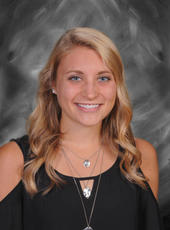 A: I am 18 years old and a senior at Kalida. My interests include running and spending time with my friends and family. In school, I am most interested in science because I plan to be a nurse. My favorite classes are anatomy and biomedical science.
A: I am 18 years old and a senior at Kalida. My interests include running and spending time with my friends and family. In school, I am most interested in science because I plan to be a nurse. My favorite classes are anatomy and biomedical science.
Q: What prompted your participation in the “We’ve Got Heart!” event, and what was your role?
A: We heard about the Ohio Heart Health Design Challenge from our teacher, Mrs. Warnecke, and that is what led to “We’ve Got Heart!” Mrs. Warnecke, my classmates and I all played large roles in planning and executing the event. Because there were so many jobs to be done, we decided to “divide and conquer.”
One of my first jobs was to make a flier to hand out to the public and to hang in our school, at Fort Jennings High School and in businesses.
Throughout the whole process, I was one of the students who made sure everything was organized and kept everyone on track. My classmates and I created multiple spreadsheets and files to track donations and T-shirt order forms. It was extremely important to stay organized throughout the whole process, and I think that helped us to be so successful.
A: What were the challenges and the rewards for helping to organize the event?
A: Our first major challenge was the time aspect. After the idea surfaced, and we got the OK from our principal, we confirmed Fort Jennings’ involvement. At that point, we had about one month to plan the whole awareness and fundraising event.
At the time, this seemed crazy, and we started to think we were in way over our heads. As we began to plan, however, things started to come together. We were surprised at the amount of donations and support we received from our community and school. This was rewarding because I can remember numerous times when people stopped me just to say how amazing this fundraiser was and what it would do for the community.
As the date of the event drew near, we were presented with another challenge. The day of the event, the weather forecast called for snow and wind. This type of weather would likely lead to school — and, possibly, the game — being cancelled. Despite the snow and wind, we continued to prepare the fundraiser the entire day just to have it cancelled that night.
We were able to turn this obstacle into a benefit, however, as we had the opportunity to sell more tickets and collect more donations that weekend before the rescheduled event the next Monday. We were able to work with uncontrollable factors and continue to make our fundraiser a success!
Q: What has been the feedback from your fellow students, teachers and the community?
A: The feedback was phenomenal. Right away, our principal was on board with our idea and wanted us to help the community.
Along with our principal, our athletic director and the principal and athletic director from Fort Jennings were also super-supportive and offered their help.
As for the students and teachers, they showed their support by buying T-shirts and raffle tickets. This goes hand in hand with the community support as the gym was packed the night of the event — an amazing sight.
We couldn’t have done the event without the support from the Kalida High School staff. During the event, many of the teachers sold raffle tickets, and our technology coordinator kept our informational slideshow going. Additionally, our art teacher worked with us to format our flier and print large signs to hang at the event.
Q: What have you learned from taking part in “We’ve Got Heart!”?
A: I learned what it takes to plan this type of event and how appreciative our community and neighboring communities really are. Although the fundraiser seemed overwhelming at times, it was well worth it for the fulfilling feeling of doing something to give back to the community. It also taught me how to communicate with adults and other students.
The most important thing I took away from this whole experience, however, is that congenital heart disease is closer to me than I thought. Before this, I never realized how many people CHD affects and that some of my friends deal with it every day. This opportunity to inform the public about CHD and help them understand what some kids in our community will deal with forever was truly amazing and will leave a mark on me.
What we presented to the community heavily outweighs any kind of profit gained from the fundraiser, and it ultimately made our communities better and more understanding of what happens around us.
